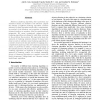Free Online Productivity Tools
i2Speak
i2Symbol
i2OCR
iTex2Img
iWeb2Print
iWeb2Shot
i2Type
iPdf2Split
iPdf2Merge
i2Bopomofo
i2Arabic
i2Style
i2Image
i2PDF
iLatex2Rtf
Sci2ools
ICPR
2004
IEEE
2004
IEEE
Landscape of Clustering Algorithms
Numerous clustering algorithms, their taxonomies and evaluation studies are available in the literature. Despite the diversity of different clustering algorithms, solutions delivered by these algorithms exhibit many commonalities. An analysis of the similarity and properties of clustering objective functions is necessary from the operational/user perspective. We revisit conventional categorization of clustering algorithms and attempt to relate them according to the partitions they produce. We empirically study the similarity of clustering solutions obtained by many traditional as well as relatively recent clustering algorithms on a number of real-world data sets. Sammon's mapping and a complete-link clustering of the inter-clustering dissimilarity values are performed to detect a meaningful grouping of the objective functions. We find that only a small number of clustering algorithms are sufficient to represent a large spectrum of clustering criteria. For example, interesting gro...
Clustering Algorithms | Complete-link Clustering | Computer Vision | ICPR 2004 | Numerous Clustering Algorithms |
| Added | 09 Nov 2009 |
| Updated | 09 Nov 2009 |
| Type | Conference |
| Year | 2004 |
| Where | ICPR |
| Authors | Anil K. Jain, Alexander P. Topchy, Martin H. C. Law, Joachim M. Buhmann |
Comments (0)

